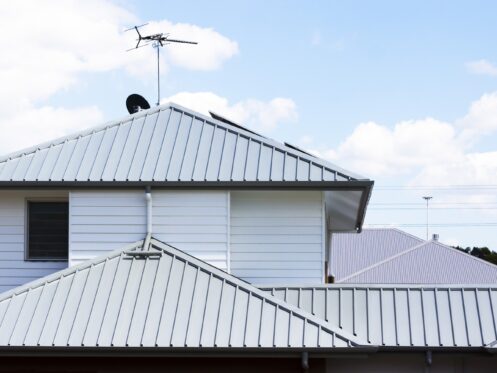As any homeowner knows, there are a multitude of decisions that have to be made while maintaining and improving your home. One such decision is choosing a type of roof for your home, and one popular option in the market today is metal roofing. As with any important decision, it’s essential to ensure that you make the best choice for both your budget and long-term needs. So how long do metal roofs last? We’ll provide an overview of what kind of lifespan you can expect from a metal roof and discuss some measures necessary to maximize your investment.
1. The Lifespan of a Metal Roof by Their Type
Metal roofs come in various types, all with their associated life expectancy. Generally, metal roofing systems can last anywhere from 40 to 70 years, depending on the type and quality of the material used.
Corrugated galvanized steel is one of the most popular metal roofing materials, and it can last up to 40 years if properly maintained. On the other hand, aluminum roofing can last up to 50 years, while copper and zinc roofs are known for having lifespans of up to 70 years. Another popular type of metal roofing is standing seam panels. These panels are highly durable and can last up to 40 years or longer with proper maintenance.
2. The Quality of the Roofing Material
A metal roof is known for its durability and longevity, but the quality of the roof plays a significant role in determining its lifespan. Inferior or cheaper materials tend to have a shorter lifespan than better-quality metal roofing materials, which can last much longer.
A high-quality metal roof will resist rust, corrosion, and even damage caused by extreme weather conditions. It will also have a proper coating to protect it from the harsh UV rays, ultimately increasing its durability. Therefore, when installing a metal roof, it is important to invest in a high-quality product to ensure longevity and avoid costly repairs in the future.
3. Proper Installation and Maintenance
Installing a metal roof is not as simple as nailing in some sheets and calling it a day. It requires a professional installation that takes into account the specific needs and requirements of your building. A company like Aurora Pro Services Heating, Air, Plumbing, Electrical, & Roofing provides metal roof installation services for Greensboro, NC and the Triad Area residents.
In addition to installation, routine roofing maintenance is necessary to ensure that your metal roof lasts as long as possible. Harsh weather, debris, and normal wear and tear can all take a toll on your metal roof over time. However, with regular maintenance, you can extend its lifespan and protect your investment for years to come.
4. The Type of Environment You Live In
Where you live also plays a role in determining the lifespan of your metal roof. Areas with extreme climate conditions, heavy rains, gusty winds, or frequent hail can sustain more wear and tear on the roof than other regions. To avoid any issues related to this type of environment, it’s best to check with a professional about what maintenance is necessary for your locale.
Also, it is best to find out what type of metal roof suits your particular environment, as some types of metal may not handle certain climate conditions. For instance, aluminum is a popular metal for roofs, but in coastal areas where there is a lot of salt air, it may be recommended to use stainless steel instead. In this case, it’s best to speak with a roofing specialist who can provide you with the most appropriate advice for your area.
5. The Attic Ventilation
Proper ventilation ensures that hot air does not accumulate in the attic, leading to heat buildup and moisture entrapment in the insulation. In turn, this can cause mold growth and wood rot, which can weaken roof support structures.
On the other hand, proper ventilation allows hot air to escape, leading to a cooler attic, reducing the energy costs for cooling homes, and prolonging the life of metal roofs. Experts recommend that attics have one square foot of ventilation per 300 square feet of attic space to ensure optimal airflow. Good attic ventilation is essential in maintaining the longevity of metal roofs, making it an important factor to consider when installing or maintaining a metal roof.
6. How the Roof Is Used
Believe it or not, how a metal roof is utilized significantly impacts its longevity. This aspect encompasses a multitude of variables, such as foot traffic, the type of building it covers, and the frequency of maintenance. For example, a metal roof installed on a warehouse constantly exposed to heavy machinery and high levels of foot traffic is likely to experience significantly more wear and tear than a residential metal roof rarely walked on.
Additionally, when things are placed on a metal roof, such as HVAC units, satellite dishes, or solar panels, it can take a toll on its structural integrity. Therefore, it is important to consider using a metal roof before installation and plan accordingly to minimize potential damage.
7. The Roof Design
A properly designed metal roof can last for decades, while a poorly designed one may need replacing after a few years. One factor in the design of a metal roof is the pitch or slope of the roof. A steeper pitch allows for better water drainage, reducing the likelihood of standing water and potential leaks.
A flat design, on the other hand, is not ideal for metal roofing as it can trap water and snow, leading to corrosion. This corrosion can cause structural damage and leave the roof susceptible to leaks. As such, a professional who understands the complexities of roof design must ensure that your metal roof lasts for as long as possible.
8. The Color of the Roof
The color of a metal roof might not be the first thing that comes to mind when considering a roof’s lifespan. However, it does play a significant role. Metal roofing comes in various colors, and each color reacts differently to heat absorption and reflection.
For instance, darker colors absorb more heat from the sun, leading to faster wear and tear. On the other hand, lighter colors are better at reflecting the sun’s rays and keeping temperatures down. As such, choosing a lighter-colored metal roof can help extend its lifespan by reducing heat absorption.
9. The Age of the Roof
As with any structure or material, exposure to weather conditions, extreme temperatures, and the wear and tear of elements will take a toll on the roofing system. With time, the metal surface can start losing its protective layer, leaving the underlying material at risk of corrosion, rust, and other damage.
As the roof sustains wear and tear, it becomes increasingly vulnerable to leaks, holes, and other problems that can develop over time. While many metal roofs can last for several decades without requiring major repairs or replacements, regular maintenance and inspections are key to ensuring the roof remains in optimal condition.
Metal roofs can last for decades with proper installation and maintenance. However, how long your metal roof lasts depends on several factors, such as the type of environment you live in, attic ventilation, the use of the roof, the design of the roof, the color of the roof, and its age. If you are looking to install a metal roof or maintain an existing one, consult a professional who understands all aspects related to metal roofs so that you can get the most out of your investment. With the right help and care, you can look forward to many years of service from your metal roof.
At Aurora Pro Services Heating, Air, Plumbing, Electrical, & Roofing, we pride ourselves in providing quality heating, cooling, plumbing, roofing, and electrical services in Greensboro, NC. Call us today to request a service.






